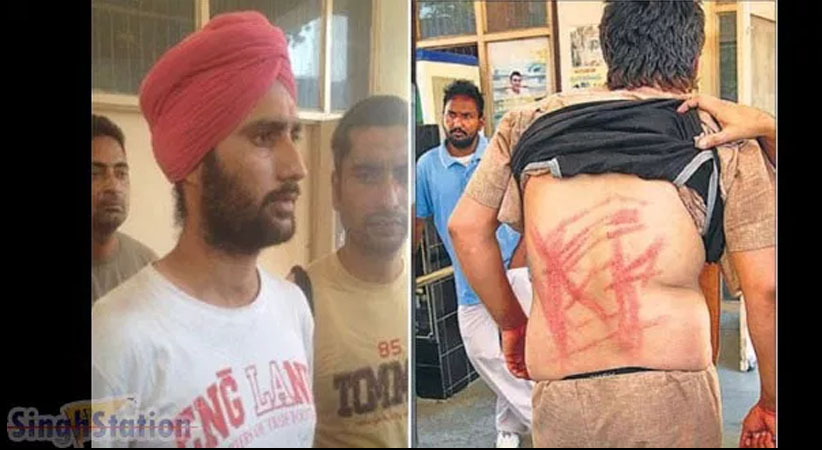More impressive than the numbers was the coalition of political and social forces that the morcha, or protest march, brought together – Dalits cutting across political factions and loyalties, members of the Left and Left-inspired groups and workers and sympathisers of the Shiv Sena. The leaders of the morcha included Prakash Ambedkar, grandson of Dalit leader BR Ambedkar and leader of the Bharatiya Republican Party Mahasangh, Communist Party of India (Marxist) leader and Rajya Sabha member Sitaram Yechury, Jawaharlal Nehru University student leader Kanhaiya Kumar, who rode pillion to reach the venue in time amidst cheers, and Sena spokesperson and Member of Parliament Sanjay Raut.
The unlikely assembly of leaders and the hundreds of thousands of people were out to send a message to the political establishment of the day: The razing of the historic Ambedkar Bhavan in Mumbai’s Dadar had incensed Ambedkarites, followers of the Dalit leader, who saw it as symbolic of the continuing assault on Ambedkar’s ideology by the BJP and allied forces.
Between the lines
The subtext of the morcha was clear too. Coming a few days after Dalit leader Ramdas Athavale had been inducted into the Modi cabinet, ostensibly to win over Dalits in Maharashtra, where municipal elections will be held next year, and Uttar Pradesh, which will be the stage of a hotly contested state election in early 2017. The protestors let Prime Minister Narendra Modi and Maharashtra Chief Minister Devendra Fadnavis know that Dalits would not be fooled by such symbolic gestures, given how the establishment continued its attack on Ambedkar’s legacy.
Ambedkar Bhavan was a modest structure in Mumbai where Ambedkar had conducted his work while in the city, where he would write while not at his large table at home, and it housed a part of his book collection. Besides these, it had the Bharat Bhushan printing press, where he had bought and installed printing machines when established publishers had refused to publish his writings critical of Hinduism. The precinct also had meeting halls and the offices of Prakash Ambedkar’s party.
The 72-year-old Ambedkar Bhavan was owned and managed by the People’s Improvement Trust set up by Ambedkar. It was also the place that the late Dalit student leader Rohith Vemula’s mother and brother had converted to Buddhism in April under the guidance of Prakash Ambedkar. And through that, it had come to acquire certain urgency in the prevailing anti-Dalit climate.
During the night of June 25-26, a large group of young men wearing Ambedkar inscribed T-shirts, ostensibly authorised by the trust itself, had razed the Bhavan. In the process, they destroyed many of the original articles there, including the press. It transpired that the trust wanted to redevelop the plot with a 17-storey grand building, to be also called Ambedkar Bhavan. The local police and municipal corporation officials were reportedly unaware of the demolition until after it was over.
Why the demolition mattered
The demolition was clearly planned. The commercial exploitation of the site had trumped the historic significance of the Ambedkar Bhavan. The unwillingness of the state government to protect the legacy structure, especially that of chief minister Fadnavis who had moved fast to inaugurate the memorial to Ambedkar to be built at nearby Indu Mills, will come back to haunt it.
Ratnakar Gaikwad, former chief secretary of Maharashtra and advisor to the trust, defended the demolition. Gaikwad fancies himself as a Dalit leader but he had no authority in the trust that allowed him to order or advise the demolition, according to a Right to Information inquiry. He also happens to be Maharashtra’s information commissioner, a post he was given after retirement. Gaikwad’s stout defence added to the sense of injury that Dalits and Ambedkarites felt.
Prakash Ambedkar and brother Anandraj called for a fitting response to it even as the Fadnavis government dithered and made meaningless noises. The Shiv Sena got involved, its leader Neelam Gorhe made her way through the rubble and said she was pained that the government could not protect and preserve Ambedkar Bhavan though it was spending crores to erect the memorial to him. The Sena, Fadnavis’s ally in government, has taken delight in embarrassing him and the BJP in the last few months.
The anti-Dalit narrative
As the anger against the demolition of the Ambedkar Bhavan gathered force, Ramdas Athavale was sworn into Modi’s cabinet during an expansion earlier this month. It fanned the flames. Here was a Dalit leader who should have been condemning the BJP governments in the state and Centre, or better still, should have prevented the demolition. Instead, he was supping with the government.
Around this time, the incident in Una, Gujarat, occurred where a group of self-styled so-called gau rakshaks, or self-styled cow protection vigilantes, publicly flogged four Dalit leather tanners for skinning the carcasses of dead cows on July 11. Dalit activists in Gujarat said such cow vigilantism had become common. The incident has led to an unprecedented Dalit uprising in the state.
In Maharashtra, there were recorded cases of honour killings and caste atrocities in the last couple of years. A small-budget film made on the issue, Sairat, in which the young Dalit man and his Maratha caste lady love were killed by her family, had turned out to be a roaring success.
In the months post the death of Rohith Vemula, a PhD student at the University of Hyderabad who had killed himself on January 17 to protest alleged discrimination by university officials against Dalit students, the news media regularly told stories of caste atrocities and assaults on Dalits across the country. The Rashtriya Swayamsevak Sangh had muddied the waters calling for a review of reservations and then backtracking.
The dominant narrative, therefore, was that in the era of BJP majority governments, with or without their sanction, anti-Dalit and Hindu fundamentalist groups were training their guns on Dalits. And the gains – however limited and debatable – of the last few decades were being threatened. It did not take much effort for Prakash and brother Anandraj Ambedkar to mobilise one of the largest morchas in Mumbai in the last five years. “I was articulating what we [Ambedkarites] were all feeling,” Prakash Ambedkar said. He has asked volunteers to do shram-daan, or voluntary labour, to rebuild the Ambedkar Bhavan later this month.
The unlikely assembly
The strength and tone of the morcha, and the coalition of leaders it brought together, made such an impact that Fadnavis announced the very next day in the state legislature that there would be an inquiry into the demolition and that his government would fund the reconstruction if the Ambedkar family agreed to accept the government’s gesture. Fadnavis also told the state legislature that an inquiry had been initiated into Gaikwad’s role.
Fadnavis was bothered about the signals that the morcha sent out not only in Maharashtra but nationally, especially in Uttar Pradesh, at a time that the BJP leadership wants to impress Dalits for their electoral worth. The young first-time chief minister has been Modi’s and Shah’s poster-boy chief minister. He could not afford to rile the Central leadership, especially at a time when the party was orchestrating to send the correct positive signals. The aftermath of Vemula’s suicide lingered, the Una incident was an embarrassment to the party, and this mammoth morcha had the ability to take down Fadnavis’s stock with the BJP leadership.
The massive morcha led to political alignments that neither Fadnavis nor his leaders could have expected. It united the anti-BJP forces – and included its ally, the Shiv Sena on its side for what it was worth. What other issues such as the untrammelled price rise and the series of corruption charges against Fadnavis’ council of ministers had not managed to achieve, the razing of Ambedkar Bhavan had: it had brought the opposition parties together and allowed them to challenge the BJP government in one voice.
At the morcha, when Kanhaiya Kumar worked the crowd against the government with his speech and the famous “azaadi” chant, the anti-establishment symbolism of his persona as the young man who challenged the Prime Minister, effortlessly carried over. The Ambedkar Bhavan was “emerging as an anti-BJP space” and the government could not tolerate it, he pointed out.
All this sent out unflattering signals about Fadnavis’ own political assessment in Maharashtra. Firstly, he had convinced the party leadership that inducting Athavale would bring benefits to the BJP. The move had come unstuck within days. Secondly, his handling of the Ambedkar Bhavan issue had brought on the collective might of an unlikely assembly of political leaders. Thirdly, he could not or did not prevent the BJP’s ally, the Shiv Sena, from crossing the line and taking a public position against the government. Together, it did not speak much for Fadnavis’s political instincts.
But what of the disparate forces that made common cause about Ambedkar Bhavan and assaults on Dalits? The Sena is likely to work this issue to the extent that it gives the party yet another plank to oppose Fadnavis. Sena chief Uddhav Thackeray has come to love the confused space he now occupies – partner in government but free to act as the principal opposition. The Sena is unlikely to be influenced by the political values that Yechury represents or the raw anti-establishment fire that Kumar fosters. The Left made its presence felt after a length of time and must find ways to keep the momentum going.
The morcha could be a landmark turning point in Dalit politics. The Ambedkar Bhavan issue brought multiple political parties that represent Dalit politics in Maharashtra, especially the splinters and factions of Republican Party of India, together. So far, so good. But the fight against the attempted co-option of Ambedkar by the BJP government and protest against assaults on Dalits cannot be complete in one morcha, however impressive and influential it was.
Articulating the Dalit angst and anguish in the current climate, and giving it a political platform, requires that Dalit leaders, including the Ambedkar siblings, bury their differences – and the creeping indifference of the last few years – and evolve a common programme. Else, they risk turning the morcha for Ambedkar Bhavan and other Dalit-related issues into mere symbolisms – a game that the BJP plays with more ruthlessness.
As Prakash Ambedkar prepared Dalit boys for shram-daan, Uttar Pradesh’s BJP leader Dayashankar Singh called BSP leader Mayawati “worse than a prostitute”. Dalit anger against the BJP continues to rise. The Ambedkar Bhavan episode has turned this narrative into one compelling tale.






